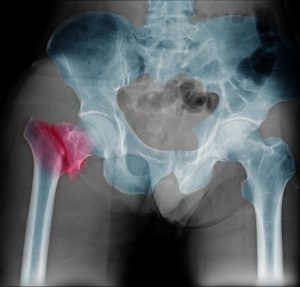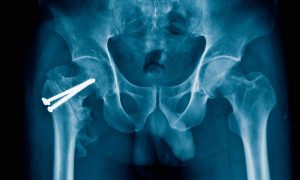HIP FRACTURES
What is a hip fracture?
 A hip fracture is a break in the upper quarter of the femur (thigh) bone. The extent of the break depends on the forces that are involved. The type of surgery used to treat a hip fracture is primarily based on the bones and soft tissues affected or on the level of the fracture. The “hip” is a ball-and-socket joint. It allows the upper leg to bend and rotate at the pelvis. An injury to the “socket” (also called the acetabulum) itself is not considered a “hip fracture.”
A hip fracture is a break in the upper quarter of the femur (thigh) bone. The extent of the break depends on the forces that are involved. The type of surgery used to treat a hip fracture is primarily based on the bones and soft tissues affected or on the level of the fracture. The “hip” is a ball-and-socket joint. It allows the upper leg to bend and rotate at the pelvis. An injury to the “socket” (also called the acetabulum) itself is not considered a “hip fracture.”
Types of Hip fractures
 Fractures of the hip are generally categorized into three types based on the location of the fracture. The fracture can occur in the joint capsule, in the top of the femur, or just below the top of the femur.
Fractures of the hip are generally categorized into three types based on the location of the fracture. The fracture can occur in the joint capsule, in the top of the femur, or just below the top of the femur.
Intracapsular Hip Fractures
Intracapsular hip fractures occur in the femoral neck. This area is called an intracapsular fracture because this portion of the femur is inside the joint capsule.
Intertrochanteric Hip fractures
Intertrochanteric means between the trochanter. The anatomy of a femur includes the greater and lesser trochanter. The Greater trochanter is a prominent ridge on top of the femur, and the lesser trochanter is a smaller ridge on the inside of the leg just below the femoral neck. An Intertrochanteric fracture is located between the two trochanters.
Subtrochanteric Hip Fractures
A subtrochanteric hip fracture is located below the lower trochanter in the femur.
WHAT ARE THE SYMPTOMS OF A HIP FRACTURE?
The patient with a hip fracture will have pain over the outer upper thigh or in the groin. There will be significant discomfort with any attempt to flex or rotate the hip. The hip may also have dislocated.
If the bone has been weakened by disease (such as a stress injury or cancer), the patient may notice aching in the groin or thigh area for a period of time before the break. If the bone is completely broken, the leg may appear to be shorter than the non-injured leg. The patient will often hold the injured leg in a still position with the foot and knee turned outward (external rotation). Some hip fractures are going to need surgical screws, plates, and nails, to properly heal. Rarely a hip fracture will be at the femoral head and require hip resurfacing or a hemiarthroplasty to repair.
Hip Fracture? Get immediate orthopedic help in north texas. 817-375-5200


